2.3.1 Comparison with Experimental Results




Next: 2.3.2 Additional Physical Phenomena
Up: 2.3 Experimental Results and
Previous: 2.3 Experimental Results and
The model 2.7 based on parabolic band, with constant
band-gap narrowing  and
and  assumed
in 2.9, is used in comparison with experimental results. An
important assumption in this model is that the conduction and valence band
shifts depend solely on the activated impurity concentration
assumed
in 2.9, is used in comparison with experimental results. An
important assumption in this model is that the conduction and valence band
shifts depend solely on the activated impurity concentration  , but not on
carrier concentrations which vary with potential. The total gap narrowing
, but not on
carrier concentrations which vary with potential. The total gap narrowing
 is modeled with an empirical expression A.25 in
Appendix A, which correlates with experimental data for electrical
gap narrowing in quasi-neutral regions from literature. Such a model is
successfully used in device modeling, e.g. in modeling diodes and
bipolar transistors [327][315][190], JFET's [317] and solar
cells [316]. We will study whether this approach is appropriate for
modeling heavily doped depleted regions. In the absence of any experimental data
in literature, symmetrical narrowing is assumed:
is modeled with an empirical expression A.25 in
Appendix A, which correlates with experimental data for electrical
gap narrowing in quasi-neutral regions from literature. Such a model is
successfully used in device modeling, e.g. in modeling diodes and
bipolar transistors [327][315][190], JFET's [317] and solar
cells [316]. We will study whether this approach is appropriate for
modeling heavily doped depleted regions. In the absence of any experimental data
in literature, symmetrical narrowing is assumed:
 .
.
To calculate the theoretical  -
- characteristics we used MINIMOS,
because of nonuniform bulk doping in test MOSFETs. A constant
characteristics we used MINIMOS,
because of nonuniform bulk doping in test MOSFETs. A constant  is
assumed in the gate area.
is
assumed in the gate area.
Integral quantities like inversion-layer charge density  , bulk surface
field
, bulk surface
field  and drain current are less influenced by an error in the gate model
than are differential quantities like gate capacitance
and drain current are less influenced by an error in the gate model
than are differential quantities like gate capacitance  . Actually, the
deviation of the quasi-static (QS) capacitance from experiment could be a direct
sense for an inaccuracy in the space-charge model and/or interface trap model
as explained later. Therefore, we choose the QS
. Actually, the
deviation of the quasi-static (QS) capacitance from experiment could be a direct
sense for an inaccuracy in the space-charge model and/or interface trap model
as explained later. Therefore, we choose the QS  -
- characteristics
to compare the calculations with experimental results. Several
characteristics
to compare the calculations with experimental results. Several
 -gate/
-gate/ -channel devices
with oxide thickness
-channel devices
with oxide thickness  ,
,  ,
,  ,
,  and
and  and
two
and
two  -gate/
-gate/ -channel devices with
-channel devices with  and
and  are
examined
are
examined . One comparison between numerically
calculated and experimental QS
. One comparison between numerically
calculated and experimental QS  -
- characteristics is given in
Figures 2.9 and 2.10. Capacitances are
measured by the split
characteristics is given in
Figures 2.9 and 2.10. Capacitances are
measured by the split  -
- technique [256]. Both measured,
gate-channel
technique [256]. Both measured,
gate-channel  and gate-bulk
and gate-bulk  capacitances are corrected due to
gate/source and gate/drain junction overlap capacitances and parasitic wiring
capacitances.
capacitances are corrected due to
gate/source and gate/drain junction overlap capacitances and parasitic wiring
capacitances.
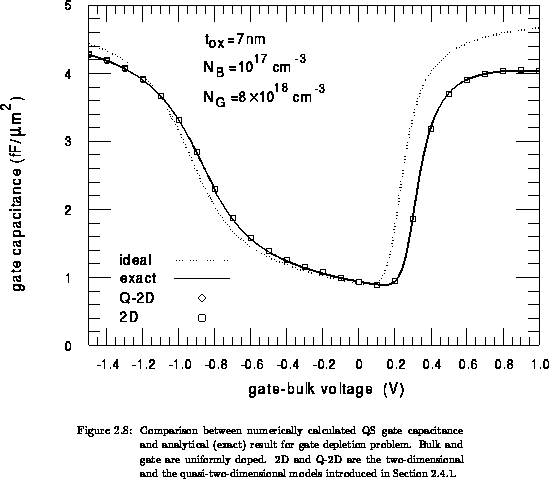
The total capacitance is the sum of the corrected values
 . From maximal
. From maximal  in strong accumulation it
follows
in strong accumulation it
follows  , where
, where
 is the channel width and
is the channel width and  is the corresponding effective
channel length. For an accurate comparison between theory and experiment it is
important to estimate properly the physical oxide thickness; the extracted
is the corresponding effective
channel length. For an accurate comparison between theory and experiment it is
important to estimate properly the physical oxide thickness; the extracted
 must provide for
must provide for  a value higher
than the highest value
measured at the strongest-accumulation point. It is known that, due to quantum
mechanical effects in accumulation layers, physical
a value higher
than the highest value
measured at the strongest-accumulation point. It is known that, due to quantum
mechanical effects in accumulation layers, physical  is always smaller
than that corresponding to maximal
is always smaller
than that corresponding to maximal  in experiments [453]. This
effect becomes quite significant for oxides thinner than
in experiments [453]. This
effect becomes quite significant for oxides thinner than  . Note that
our aim is not to fit the
. Note that
our aim is not to fit the  -
- characteristic in the intermediate voltage
range, but to extract an eventual small deviation of the theory from experiment.
For the device in Figure 2.9 we estimate
characteristic in the intermediate voltage
range, but to extract an eventual small deviation of the theory from experiment.
For the device in Figure 2.9 we estimate

 .
.
The QS gate capacitance, defined by 2.21, is calculated
by MINIMOS applying the
method [167]

 is the total charge in the gate including interface
states. It can be numerically obtained by calculating the flux of the electric
field through a contour in the oxide around the gate
(Figure 2.14). In applying 2.24 we used
is the total charge in the gate including interface
states. It can be numerically obtained by calculating the flux of the electric
field through a contour in the oxide around the gate
(Figure 2.14). In applying 2.24 we used
 ,
,  and froze the grid.
Comparing the numerical capacitance with the analytical results from
Section 2.2 for long-channel devices with uniformly
doped bulk we found this simple technique to be very accurate. One example is
demonstrated in Figure 2.8. The numerical error is small as
expected, whereas an influence of the discretization error is well suppressed
by using the same grid for both bias points,
and froze the grid.
Comparing the numerical capacitance with the analytical results from
Section 2.2 for long-channel devices with uniformly
doped bulk we found this simple technique to be very accurate. One example is
demonstrated in Figure 2.8. The numerical error is small as
expected, whereas an influence of the discretization error is well suppressed
by using the same grid for both bias points,  and
and
 .
.
For a comparison with the experiment we only include the field flux from the
source-subdiffusion to the drain-subdiffusion in calculating  , because
the fluxes in the gate/subdiffusion overlap region and the gate side-wall
fluxes which represent the parasitic overlap capacitances, have already been
subtracted from the experimental data. Moreover, numerical calculations show
that these parasitic capacitances are weakly bias-dependent from strong
accumulation to strong inversion, as usually assumed in the split
, because
the fluxes in the gate/subdiffusion overlap region and the gate side-wall
fluxes which represent the parasitic overlap capacitances, have already been
subtracted from the experimental data. Moreover, numerical calculations show
that these parasitic capacitances are weakly bias-dependent from strong
accumulation to strong inversion, as usually assumed in the split  -
- technique. Therefore, it is confirmed that the assumption of constant parasitic
capacitances does not introduce a relevant error in our analysis.
technique. Therefore, it is confirmed that the assumption of constant parasitic
capacitances does not introduce a relevant error in our analysis.
The channel doping profile is obtained by fitting experimental  characteristics in bulk depletion from the minimum of the
characteristics in bulk depletion from the minimum of the  -
- characteristics to the flat-band applying numerical simulation in 2-3 loops.
We neglected traps at the oxide/bulk interface and assumed for
characteristics to the flat-band applying numerical simulation in 2-3 loops.
We neglected traps at the oxide/bulk interface and assumed for  and
and
 the values determined below. The doping profile has a small influence
on the inversion side of the
the values determined below. The doping profile has a small influence
on the inversion side of the  -
- characteristic far above the threshold,
which we focus on in the study.
characteristic far above the threshold,
which we focus on in the study.  is estimated by matching simulated
is estimated by matching simulated  with the experimental data at low effective-gate bias
with the experimental data at low effective-gate bias  . Higher
. Higher
 values enable better matching experimental data at a higher gate bias,
but worse
at lower
values enable better matching experimental data at a higher gate bias,
but worse
at lower  . Arbitrarily assumed positive fixed charge at the
gate/oxide interface of
. Arbitrarily assumed positive fixed charge at the
gate/oxide interface of  improves the match with
measured
improves the match with
measured  (see Figure 2.9). At higher
(see Figure 2.9). At higher
 the charge
the charge  has a minor impact on the
has a minor impact on the  -
- characteristics. Regarding the band-gap shift
characteristics. Regarding the band-gap shift  , it has
a direct influence on the threshold voltage and the flat-band potential. The
impact of band-gap narrowing is very small, far above the threshold voltage.
, it has
a direct influence on the threshold voltage and the flat-band potential. The
impact of band-gap narrowing is very small, far above the threshold voltage.
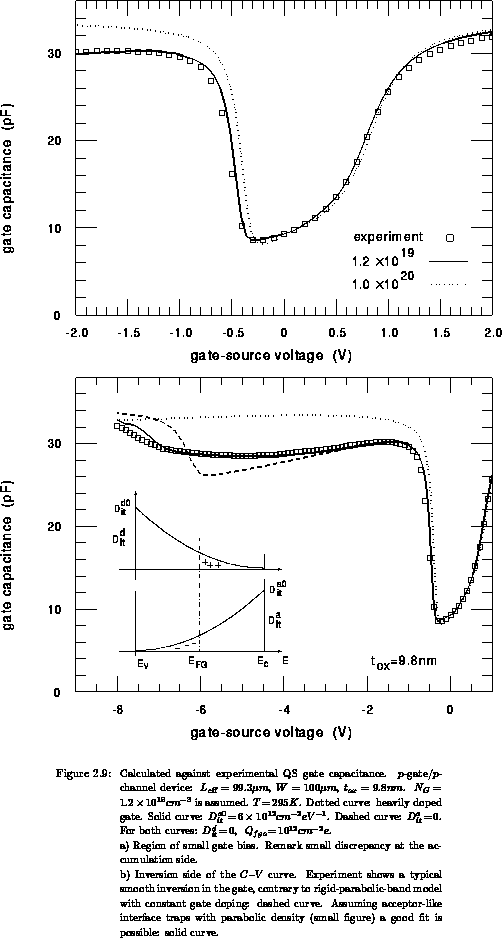
A comparison with measurements shown in Figure 2.9
clearly demonstrates that
the capacitance resulting from the application of the rigid-parabolic-band
model and constant doping near the gate/oxide interface (dashed curve)
deviates from the experiment on the inversion side.
This disagreement between theory and experiment cannot be eliminated by
neither varying the gate doping  , bulk doping nor the fixed charge at the
gate/oxide interface
, bulk doping nor the fixed charge at the
gate/oxide interface  . The calculated slope of the
. The calculated slope of the  -
- curve is
larger than the experimental one. Note that we have neglected all bulk,
grain-boundary and interface traps in the polysilicon in the calculation.
curve is
larger than the experimental one. Note that we have neglected all bulk,
grain-boundary and interface traps in the polysilicon in the calculation.
A second observation is that the inversion in the gate is smooth, while the
calculation shows a fast recovery of the gate capacitance to the
 limit for both, MB and FD statistics in the gate.
limit for both, MB and FD statistics in the gate.
These findings may be an indication for inaccuracy in the space-charge and/or
interface-trap model in the gate. To understand this claim remember that the
relationship between the oxide field  and the surface potential in the
gate
and the surface potential in the
gate  reads
reads

in the general case.  is the space charge in the gate and
is the space charge in the gate and  is the
interface charge. The semiconductor capacitance
is the
interface charge. The semiconductor capacitance  in the gate including
interface traps is given by 2.23 resulting in
in the gate including
interface traps is given by 2.23 resulting in

The oxide field  depends on the voltage drop in the oxide. When the gate
is doped moderately or heavily,
depends on the voltage drop in the oxide. When the gate
is doped moderately or heavily,  is much larger than
is much larger than  in the
gate, as is the case in Figure 2.9 on the inversion side
of the characteristics. Therefore,
in the
gate, as is the case in Figure 2.9 on the inversion side
of the characteristics. Therefore,  is slightly influenced by an error
in
is slightly influenced by an error
in  and
and  and may be considered as constant in
relationship 2.26 with respect to changes in the gate-model.
In addition, semiconductor capacitance in the bulk defined
by 2.23 is very large. As a consequence, deviations of
and may be considered as constant in
relationship 2.26 with respect to changes in the gate-model.
In addition, semiconductor capacitance in the bulk defined
by 2.23 is very large. As a consequence, deviations of  from experiment are exclusively due to
from experiment are exclusively due to  , whereas this capacitance is
directly dependent on
, whereas this capacitance is
directly dependent on  and
and  . At
the other hand,
. At
the other hand,  depends on
depends on  by 2.25. We
may conclude that
by 2.25. We
may conclude that  resulting from the rigid-parabolic-band model
with constant band-gap narrowing cannot explain the experimental results, if we
assume that the interface traps
resulting from the rigid-parabolic-band model
with constant band-gap narrowing cannot explain the experimental results, if we
assume that the interface traps  are not responsible for this finding.
are not responsible for this finding.
An evident engineering explanation that the nonuniform gate doping in direction
perpendicular to the interface can account for these effects should be
appreciated as well.
A simple engineering approach to improve fitting experimental data using the
present model is to assume acceptor-like traps at the gate/oxide interface in
 -gate/
-gate/ -channel devices. In case of an
-channel devices. In case of an  -type gate donor-like traps
would have to be assumed. We found that acceptor-like traps with a parabolic
density in energy space
-type gate donor-like traps
would have to be assumed. We found that acceptor-like traps with a parabolic
density in energy space

can satisfactorily reproduce our experimental data. In this model,  or
or  are the only variable parameters. All
are the only variable parameters. All  -gate/
-gate/ -channel
devices considered in this study have been fabricated with the same process,
except for the thickness of the final gate-oxide. We were able to fit all
-channel
devices considered in this study have been fabricated with the same process,
except for the thickness of the final gate-oxide. We were able to fit all
 -
- curves for different oxide thickness using the same value of
curves for different oxide thickness using the same value of
 for an assumed constant
for an assumed constant  and
and  . For a
. For a
 -gate/
-gate/ -channel device with the thickest gate oxide the result is shown
in Figure 2.11.
-channel device with the thickest gate oxide the result is shown
in Figure 2.11.
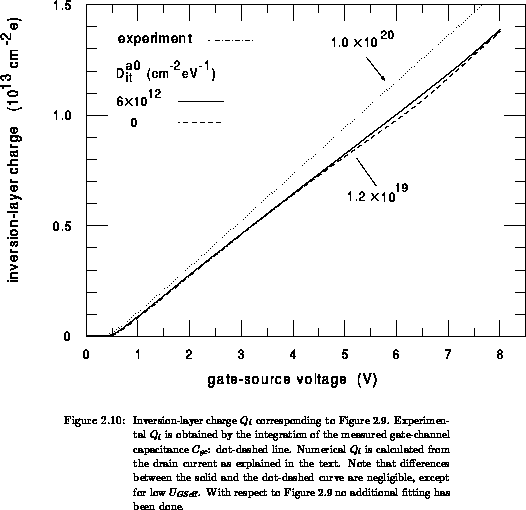
Differences between calculated and experimental capacitances can be observed
on the accumulation side too; Figures 2.9
and 2.12. The experimental data lie below the calculated
curve, although both characteristics match at flat-band and in the strong
accumulation limit.
Comparison between inversion-layer charge densities  corresponding to
Figures 2.9 is given in Figure 2.10.
Experimental
corresponding to
Figures 2.9 is given in Figure 2.10.
Experimental  per unit area is calculated by the numerical integration of
the experimental gate-channel capacitance
per unit area is calculated by the numerical integration of
the experimental gate-channel capacitance  and dividing the
result with
and dividing the
result with  . Simulated
. Simulated  is calculated from
the MINIMOS
drain current using the relation
is calculated from
the MINIMOS
drain current using the relation  in the linear region. The dependence of
in the linear region. The dependence of  on the transverse field has been
suppressed in the simulation. This has no influence on
on the transverse field has been
suppressed in the simulation. This has no influence on  and
and  because
the bulk is in quasi-equilibrium
because
the bulk is in quasi-equilibrium . The value of
. The value of  in the
active region near the interface is known exactly, as this is an input to the
simulation. This technique to calculate
in the
active region near the interface is known exactly, as this is an input to the
simulation. This technique to calculate  is simpler and more accurate than
the integration of
is simpler and more accurate than
the integration of  across the channel used in [439][418]. For
comparison in Figure 2.10, no additional fitting has been
performed with respect to Figure 2.9. The agreement between
calculated and measured
across the channel used in [439][418]. For
comparison in Figure 2.10, no additional fitting has been
performed with respect to Figure 2.9. The agreement between
calculated and measured  is very good, even without assuming traps at the
gate/oxide interface (dashed curve).
is very good, even without assuming traps at the
gate/oxide interface (dashed curve).
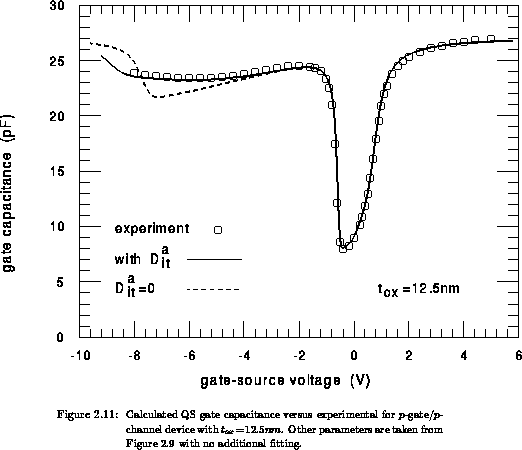
In real devices, the error in  is smaller than the error in
is smaller than the error in  , as it
is discussed in more detail in Section 2.4.2. Let us
assume a positive error in
, as it
is discussed in more detail in Section 2.4.2. Let us
assume a positive error in  due to an inaccuracy of the gate-model. This
error produces a positive error in
due to an inaccuracy of the gate-model. This
error produces a positive error in  and
and  . The surface mobility
. The surface mobility
 decreases due to a higher
decreases due to a higher  (at room temperature). The errors in
(at room temperature). The errors in
 and
and  partially compensate each other, leading to a smaller error
in the drain current
partially compensate each other, leading to a smaller error
in the drain current  than in the channel-charge
than in the channel-charge  .
.
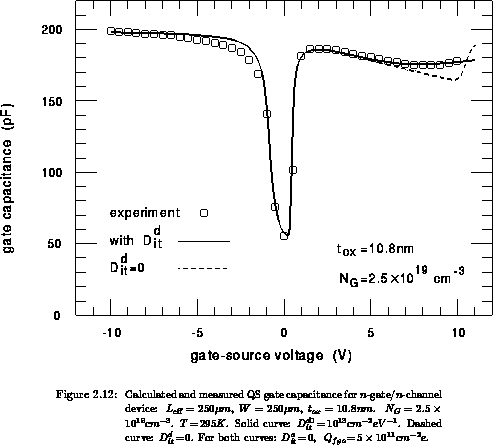
Measurements on  -gate/
-gate/ -channel devices shown in
Figure 2.12 lead to the same conclusions as for
-channel devices shown in
Figure 2.12 lead to the same conclusions as for
 -gate/
-gate/ -channel devices. In addition, we analyzed several QS
-channel devices. In addition, we analyzed several QS  -
- characteristics published in literature: Fig.1 and Fig.2 in [60],
Fig.5(a) in [512], Fig.1 in [281] and Fig.10 in [28].
Similar deviations are found. None of these data-sets can be reproduced
assuming the rigid-parabolic-band model and constant gate doping near the
interface. An inspection of the data shows that the observed phenomena are
reproducible and seem to be independent of the specific technological process
and of the type of gate (
characteristics published in literature: Fig.1 and Fig.2 in [60],
Fig.5(a) in [512], Fig.1 in [281] and Fig.10 in [28].
Similar deviations are found. None of these data-sets can be reproduced
assuming the rigid-parabolic-band model and constant gate doping near the
interface. An inspection of the data shows that the observed phenomena are
reproducible and seem to be independent of the specific technological process
and of the type of gate ( or
or  -type, polysilicon or amorphous silicon).
The observations are summarized below:
-type, polysilicon or amorphous silicon).
The observations are summarized below:

- Strong accumulation: the calculated
 is higher than the
experimental, although they match at flat-band and in the
is higher than the
experimental, although they match at flat-band and in the
 limit.
limit.

- Gate depletion: the experimental
 is weakly dependent on
is weakly dependent on
 , while the calculated
, while the calculated  decreases strongly with
increasing
decreases strongly with
increasing  .
.

- Gate inversion: contrary to experiment which shows a smooth
inversion, the calculated
 recovers rapidly to
recovers rapidly to
 .
.




Next: 2.3.2 Additional Physical Phenomena
Up: 2.3 Experimental Results and
Previous: 2.3 Experimental Results and
Martin Stiftinger
Sat Oct 15 22:05:10 MET 1994
 and
and  assumed
in 2.9, is used in comparison with experimental results. An
important assumption in this model is that the conduction and valence band
shifts depend solely on the activated impurity concentration
assumed
in 2.9, is used in comparison with experimental results. An
important assumption in this model is that the conduction and valence band
shifts depend solely on the activated impurity concentration  , but not on
carrier concentrations which vary with potential. The total gap narrowing
, but not on
carrier concentrations which vary with potential. The total gap narrowing
 is modeled with an empirical expression A.25 in
Appendix A, which correlates with experimental data for electrical
gap narrowing in quasi-neutral regions from literature. Such a model is
successfully used in device modeling, e.g. in modeling diodes and
bipolar transistors [327][315][190], JFET's [317] and solar
cells [316]. We will study whether this approach is appropriate for
modeling heavily doped depleted regions. In the absence of any experimental data
in literature, symmetrical narrowing is assumed:
is modeled with an empirical expression A.25 in
Appendix A, which correlates with experimental data for electrical
gap narrowing in quasi-neutral regions from literature. Such a model is
successfully used in device modeling, e.g. in modeling diodes and
bipolar transistors [327][315][190], JFET's [317] and solar
cells [316]. We will study whether this approach is appropriate for
modeling heavily doped depleted regions. In the absence of any experimental data
in literature, symmetrical narrowing is assumed:
 .
.




 -
- characteristics we used MINIMOS,
because of nonuniform bulk doping in test MOSFETs. A constant
characteristics we used MINIMOS,
because of nonuniform bulk doping in test MOSFETs. A constant  , bulk surface
field
, bulk surface
field  and drain current are less influenced by an error in the gate model
than are differential quantities like gate capacitance
and drain current are less influenced by an error in the gate model
than are differential quantities like gate capacitance  . Actually, the
deviation of the quasi-static (QS) capacitance from experiment could be a direct
sense for an inaccuracy in the space-charge model and/or interface trap model
as explained later. Therefore, we choose the QS
. Actually, the
deviation of the quasi-static (QS) capacitance from experiment could be a direct
sense for an inaccuracy in the space-charge model and/or interface trap model
as explained later. Therefore, we choose the QS  -gate/
-gate/ ,
,  ,
,  ,
,  and
and  and
two
and
two  -gate/
-gate/ and
and  are
examined
are
examined
 and gate-bulk
and gate-bulk  capacitances are corrected due to
gate/source and gate/drain junction overlap capacitances and parasitic wiring
capacitances.
capacitances are corrected due to
gate/source and gate/drain junction overlap capacitances and parasitic wiring
capacitances.

 . From maximal
. From maximal  , where
, where
 is the channel width and
is the channel width and  is the corresponding effective
channel length. For an accurate comparison between theory and experiment it is
important to estimate properly the physical oxide thickness; the extracted
is the corresponding effective
channel length. For an accurate comparison between theory and experiment it is
important to estimate properly the physical oxide thickness; the extracted
 must provide for
must provide for  a value higher
than the highest value
measured at the strongest-accumulation point. It is known that, due to quantum
mechanical effects in accumulation layers, physical
a value higher
than the highest value
measured at the strongest-accumulation point. It is known that, due to quantum
mechanical effects in accumulation layers, physical  . Note that
our aim is not to fit the
. Note that
our aim is not to fit the 

 is the total charge in the gate including interface
states. It can be numerically obtained by calculating the flux of the electric
field through a contour in the oxide around the gate
(Figure
is the total charge in the gate including interface
states. It can be numerically obtained by calculating the flux of the electric
field through a contour in the oxide around the gate
(Figure  ,
,  and froze the grid.
Comparing the numerical capacitance with the analytical results from
Section
and froze the grid.
Comparing the numerical capacitance with the analytical results from
Section  and
and
 .
.
 , because
the fluxes in the gate/subdiffusion overlap region and the gate side-wall
fluxes which represent the parasitic overlap capacitances, have already been
subtracted from the experimental data. Moreover, numerical calculations show
that these parasitic capacitances are weakly bias-dependent from strong
accumulation to strong inversion, as usually assumed in the split
, because
the fluxes in the gate/subdiffusion overlap region and the gate side-wall
fluxes which represent the parasitic overlap capacitances, have already been
subtracted from the experimental data. Moreover, numerical calculations show
that these parasitic capacitances are weakly bias-dependent from strong
accumulation to strong inversion, as usually assumed in the split  characteristics in bulk depletion from the minimum of the
characteristics in bulk depletion from the minimum of the  the values determined below. The doping profile has a small influence
on the inversion side of the
the values determined below. The doping profile has a small influence
on the inversion side of the  . Higher
. Higher
 improves the match with
measured
improves the match with
measured  (see Figure
(see Figure  has a minor impact on the
has a minor impact on the  , it has
a direct influence on the threshold voltage and the flat-band potential. The
impact of band-gap narrowing is very small, far above the threshold voltage.
, it has
a direct influence on the threshold voltage and the flat-band potential. The
impact of band-gap narrowing is very small, far above the threshold voltage.

 limit for both, MB and FD statistics in the gate.
limit for both, MB and FD statistics in the gate.
 and the surface potential in the
gate
and the surface potential in the
gate  reads
reads

 is the space charge in the gate and
is the space charge in the gate and  in the gate including
interface traps is given by
in the gate including
interface traps is given by 
 is much larger than
is much larger than  and
and  and may be considered as constant in
relationship
and may be considered as constant in
relationship  and
and  . At
the other hand,
. At
the other hand, 
 or
or  are the only variable parameters. All
are the only variable parameters. All 
 and dividing the
result with
and dividing the
result with  . Simulated
. Simulated  in the linear region. The dependence of
in the linear region. The dependence of  on the transverse field has been
suppressed in the simulation. This has no influence on
on the transverse field has been
suppressed in the simulation. This has no influence on  across the channel used in
across the channel used in 
 is smaller than the error in
is smaller than the error in  than in the channel-charge
than in the channel-charge 

 , while the calculated
, while the calculated